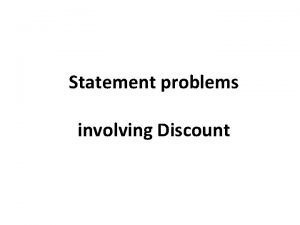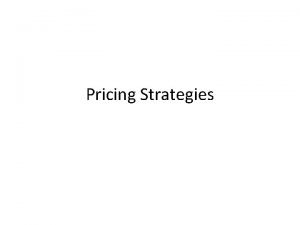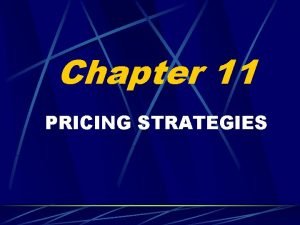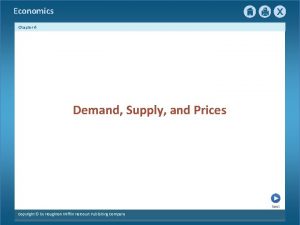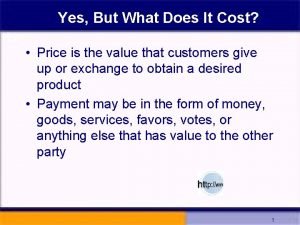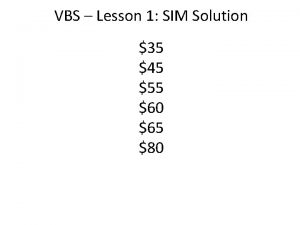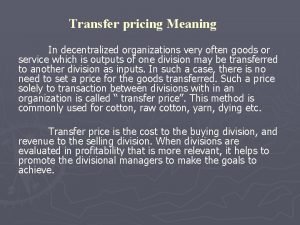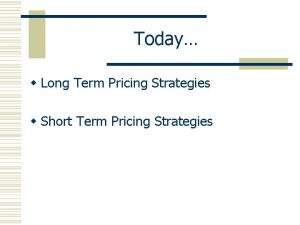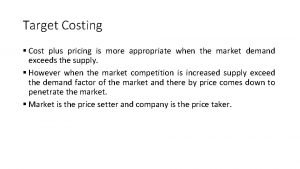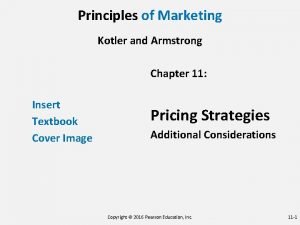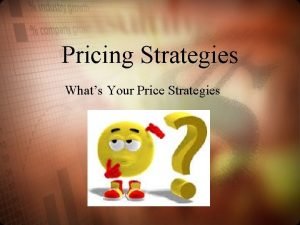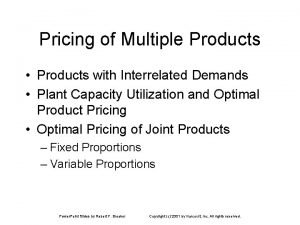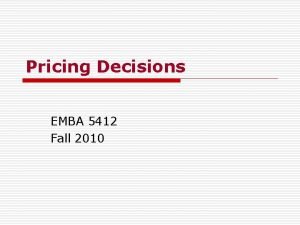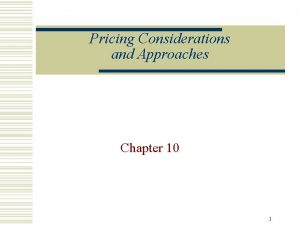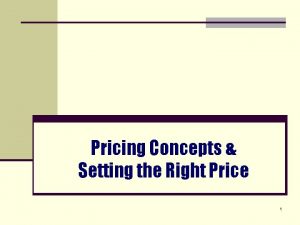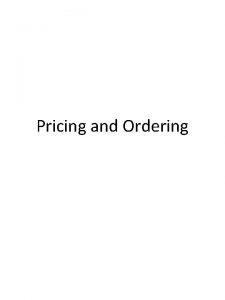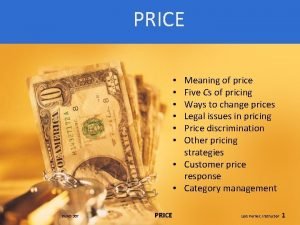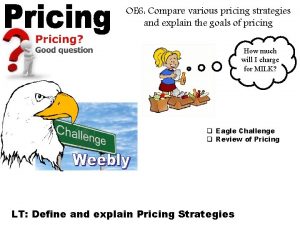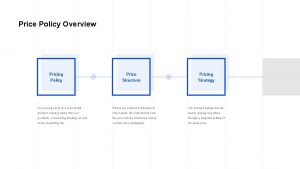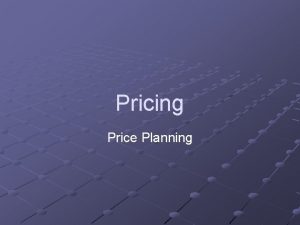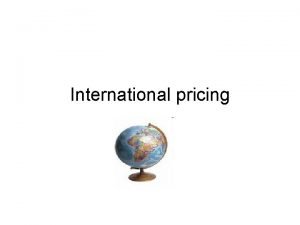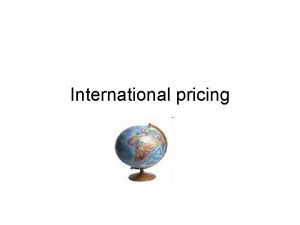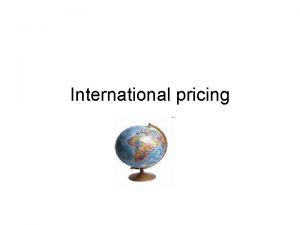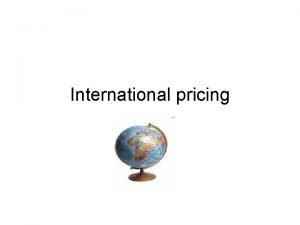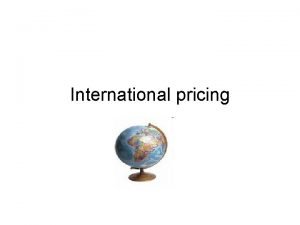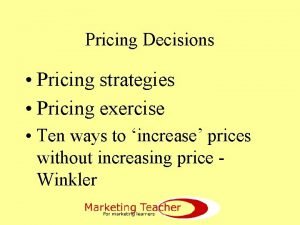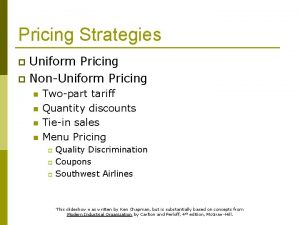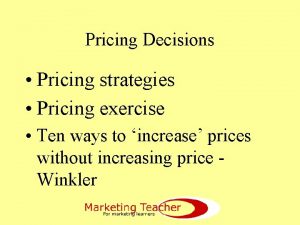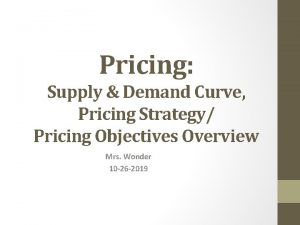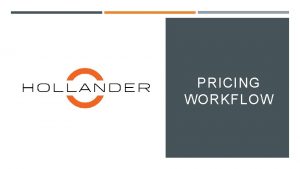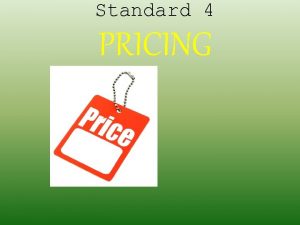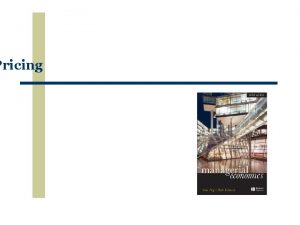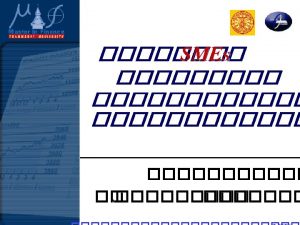Slide 16 1 Price Pricing Chapter 16 Slide


















































- Slides: 50

Slide 16. 1 Price Pricing Chapter 16

Slide 16. 2 Introduction • Companies face dynamic pricing challenges from local and international markets and are impacted from a variety of sources including macro and micro economic issues and competitors. • Price is equated to the sum of the values that consumers exchange for the benefits of having or using the product or service. • Price is one of the most important and far-reaching of the variables that marketing managers control. Price is the only element of the marketing mix that produces revenues.

Slide 16. 3 Price defined • Price is the amount of money charged for a product or service, or the sum of the values that consumers exchange for the benefits of having or using the product or service.

Slide 16. 4 Internal factors affecting price • • Company’s marketing objectives Marketing mix strategy Costs Organisation structure

Slide 16. 5 Marketing objectives • Pricing should augment the marketing mix strategy • Marketing objectives are reflected in the pricing decisions and include – – – Survival Current profit maximisation Market share maximisation Product-quality leadership Full cost recovery • Non profit hospitals – Partial cost recovery • Utilised by non profit organisations

Slide 16. 6 Marketing mix strategy • Price decisions are coordinated with product design, distribution and promotional decisions to form an effective integrated marketing programme. • Various strategies can be used depending upon the type of product and the environment in which it is involved. • Frequently pricing decisions are made first and the marketing mix evolves around that. • De-emphasis of price by using the other marketing mix tools to create non-price positions based upon differentiation and value.

Slide 16. 7 Figure 16. 1 Factors affecting price decisions

Slide 16. 8 Gucci’s very strong image and reputation as a prestigious brand mean that customers are willing to pay for the fashion house’s expensive fragrances. Source: Advertising Archives. Reproduced with permission.

Slide 16. 9 Costs • Types of cost – Fixed costs that do not vary with production or sales level. – Variable costs vary with level of production. – Total costs, sum of variable and fixed costs.

Slide 16. 10 Costs at different levels of production Figure 16. 2 Cost per unit at different levels of production

Slide 16. 11 Costs as a function of production experience Figure 16. 3 Cost per unit as a function of accumulated production: the experience curve

Slide 16. 12 External factors affecting pricing decisions External factors include the nature of the market and demand, competition and other environmental elements. • The market and demand • Costs set the lower limit and demand sets the upper limit of price. This price-demand relationship is of fundamental importance to marketers.

Slide 16. 13 Pricing in different types of market – Pure competition markets • Uniform commodity • No single buyer or seller has much effect on the market price • Marketing mix has little impact

Slide 16. 14 Pricing in different types of market – Monopolistic competition • Buyers and sellers trade over a range of prices • Emphasis upon differentiation through the marketing mix

Slide 16. 15 Pricing in different types of market – Oligopolistic competition • Few sellers highly sensitive to each other’s price and marketing strategies

Slide 16. 16 Pricing in different types of market – Pure monopoly • Single seller controlling the market

Slide 16. 17 Analysing the price-demand relationship Figure 16. 4 Inelastic and elastic demand

Slide 16. 18 Price elasticity of demand – A measure of the sensitivity of demand to changes in price. • Price elasticity of demand = % change in quantity demanded % change in price – Buyers are less price sensitive if product is unique and high in quality or image. – If demand is elastic, producers will lower price and generate more total revenue through greater demand at the lower price.

Slide 16. 19 Price influence on profits – Profit is the balance of income generated minus the costs incurred to sell the product – Many financial management ratios • Return on investment (ROI) • Return on sales • (EVA) Economic Value Added

Slide 16. 20 Competitors and other external factors impacting price • Competitors’ costs, prices and offers – Competitor price benchmarking gives a good indication of market price acceptance levels. • Economic conditions such as recession. • Resellers and intermediaries. • Governmental influences such as tariffs on imports. • Social concerns

Slide 16. 21 Pricing considerations • Companies thus set prices according to 4 sets of factors: – costs – consumer perception – competitors’ prices – societal consideration.

Slide 16. 22 Pricing objectives • Income related – • Volume related – • how many units can we sell? Competition related – • how much money can we make? what share of the available business do we want? Societal – what are our responsibilities to our customers and society as a whole?

Slide 16. 23 Pricing objectives Figure 16. 5 Primary considerations in price settings

Slide 16. 24 1. Cost based pricing • Cost-plus pricing – Adding a standard mark-up to the cost of the product. • Mark-up/down – The difference between selling price and cost as a percentage of selling price or cost • Break-even analysis and target profit pricing – Setting price to break even on the costs of making and marketing a product.

Slide 16. 25 Figure 16. 6 Break-even chart for determining target price *Assumes a fixed cost of € 300, 000 and a constant unit variable cost of € 10. Table 16. 2 Break-even volume and profits at different prices

Slide 16. 26

Slide 16. 27 2. Value based pricing • Setting price based on the buyers’ perceptions of product values rather than on the cost. • Underlying principle is to offer the right combination of quality and good service at a fair price. • Everyday low pricing is an important aspect of value pricing at the retail level.

Slide 16. 28 Cost-based vs. value-based pricing Figure 16. 7 Cost-based versus value-based pricing Source: The Strategy and Tactics of Pricing, 3 rd edn by Thomas T. Nagle and Reed K. Holden (2002), p. 4. Reprinted by permission of Pearson Education, Inc. , Upper Saddle River, NJ 07458.

Slide 16. 29 3. Competition based pricing • Going-rate pricing – Setting price based largely on following competitors’ prices rather than on company costs or demand. • Sealed-bid pricing – Potential buyers submit sealed bids, and the item is awarded to the buyer who offers the best price. • English auction is where the price is raised until only one bidder remains. • Dutch auction is where prices start high and are lowered successively until someone buys. • Collective buying is where an increasing number of customers agree to buy as prices are lowered to the final bargain price. • Reverse auction is where the customers name the price that they are willing to pay for an item and seek a company willing to sell.

Slide 16. 30 New product price setting • Setting the price for new products is complex and challenging. • Different strategies will be used if the product is an imitator of an existing product versus an innovative product that is patent protected.

Slide 16. 31 Figure 16. 8 Four price-positioning strategies

Slide 16. 32 For imitation products there are four options: • Premium pricing strategy – High quality and highest price charged. • Economy pricing – Lower quality and lower priced product. • Good value strategy – Strategy used to attack a market leader and uses a ‘strap-line’, which is an encompassing slogan used in conjunction with a brand’s name, advertising and other promotions. • Overcharging strategy – Prices charged in relation to quality.

Slide 16. 33 Pricing for new products with innovative features and benefits: • Market skimming pricing • Pricing strategy used for new products that have unique features and benefits over the competition. • A high price is set for the new product to skim the maximum price and generate the most profit. • Market penetration pricing • Initial low price to penetrate the market and convert as many buyers onto the new product and grab a large market share. • This is a short-term strategy that is dangerous and needs to be supported by a robust range of products to leverage against.

Slide 16. 34 Product-mix pricing strategies (1) • Product line pricing – Setting the price steps between various products in a product line, based on cost differences between the products, customer evaluations of the different features and the competitors’ pricing. • Optional-product pricing – The pricing of optional or accessory products along with a main product. • Captive-product pricing – Setting a price for products that must be used in conjunction with a main product, such as blades for a razor and film for a camera.

Slide 16. 35 Product-mix pricing strategies (2) • By-product pricing – Using the by-product pricing method, the manufacturer seeks markets for the by-products of the main production and recoups costs of waste from the production process. – This may include the metal shavings from steel cutting, being gathered and processed as scrap metal. • Product bundle pricing – Strategy used to combine several products and offering the bundle of products at a reduced rate, thus leveraging the entire range of products.

Slide 16. 36 Product-mix pricing strategies (3) Table 16. 4 Product-mix pricing strategies

Slide 16. 37 Price adjustment strategies Table 16. 5 Price adjustment strategies

Slide 16. 38 Discount and allowance pricing • Basic price adjustments to reward loyalty – Cash discount – Volume or quantity discount – Quantity premium – Functional discount (trade discount) – Seasonal discount – Trade-in allowance – Promotional allowance

Slide 16. 39 Segmented pricing • Segmented pricing allows for differences in customers, products and locations. The differences in prices are not based on differences in cost. – Customer-segment pricing – Product-form pricing – Location pricing – Time pricing

Slide 16. 40 Psychological pricing • A pricing approach that considers the psychology of prices and not simply the economics; the price is used to say something about the product. – Includes reference pricing, which are prices that are set in buyers’ minds and refer to when they look at a given product.

Slide 16. 41 Promotional pricing • Temporarily pricing products below the list price and sometimes even below cost, to increase short-run sales. • Dangers include creating ‘deal prone’ customers and the risk of precipitating price wars.

Slide 16. 42 Geographical pricing (1) • Pricing based on where the customers are located. • Free on board FOB-origin pricing – Goods are placed free on board a carrier; the customer then pays the freight from the factory to the destination. • Uniform delivered pricing – Company charges the same price plus freight to all customers, regardless of their location.

Slide 16. 43 Geographical pricing (2) • Zone pricing – Company sets up different trading zones. All customers within a specified zone pay the same price. The more distant the zone, the higher the price. • Basing-point pricing – Seller specifies a specific city as a basing point and charges all customers the freight cost from that city to the customer location, regardless of the city from which the goods are actually shipped. • Freight-absorption pricing – Company absorbs all or part of the actual freight charges in order to get business.

Slide 16. 44 International pricing • Globalisation and the development of international pricing strategies offer many challenges and complexities to companies. • Prices will be influenced by: – – – economic conditions competitive situations laws regulations sophistication of the retailing and wholesaler environments.

Slide 16. 45 Price changes • Initiating price cuts – Excess capacity – Follow the leader – Response to falling market share – Domination through lower costs

Slide 16. 46 Price changes • Initiating price increases – Can be extremely beneficial profit wise but care needed regarding elasticity of demand. – Cost inflation.

Slide 16. 47 Price changes • Buyer reactions to price changes – Do not interpret in a straight forward way. – Very sensitive and unexpected reactions abound.

Slide 16. 48 Price changes • Competitor reactions to price changes – Competitors more likely to react if number of firms are small and the product is uniform. – Variable response to price changes based upon the competitive market position.

Slide 16. 49 Figure 16. 9 Assessing and responding to a competitor’s price cut

Slide 16. 50 Four typical responses to a competitor’s change in price: • • Reduce price Raise perceived quality Improve quality and increase price Launch low-price ‘fighting brand’
 Price ceiling at price floor kahulugan
Price ceiling at price floor kahulugan Toe and heel dance
Toe and heel dance Marked price-selling price=
Marked price-selling price= Installment payment system meaning
Installment payment system meaning Define strategic sourcing
Define strategic sourcing Price discovery and price determination
Price discovery and price determination Chapter 26 pricing strategies answer key
Chapter 26 pricing strategies answer key Chapter 27 pricing math
Chapter 27 pricing math Chapter 11 the price strategy worksheet answers
Chapter 11 the price strategy worksheet answers Chapter 26 pricing strategies
Chapter 26 pricing strategies How to factor a binomial
How to factor a binomial Chapter 6 section 1 price supply and demand together
Chapter 6 section 1 price supply and demand together Yes of cost
Yes of cost Knowledge matters concessions sim answers
Knowledge matters concessions sim answers Ltl blanket pricing
Ltl blanket pricing Transfer price meaning
Transfer price meaning Transfer pricing example
Transfer pricing example Short term pricing strategies
Short term pricing strategies Nature of price in marketing
Nature of price in marketing Federico bandi
Federico bandi Arbitrage pricing theory and multifactor models
Arbitrage pricing theory and multifactor models Tesla pricing strategy
Tesla pricing strategy Tele
Tele Cost plus pricing vs target costing
Cost plus pricing vs target costing Sphereshield channel management
Sphereshield channel management Rate fences services marketing
Rate fences services marketing System center pricing
System center pricing Serena deployment automation
Serena deployment automation Biztalk360 pricing
Biztalk360 pricing Balabit vs cyberark
Balabit vs cyberark What is price matching
What is price matching Principles of marketing chapter 11
Principles of marketing chapter 11 Captive pricing
Captive pricing Destroyer pricing
Destroyer pricing Vieshow ticket price
Vieshow ticket price Captive-product pricing
Captive-product pricing Pricing of multiple products
Pricing of multiple products Transfer pricing examples
Transfer pricing examples General pricing approaches
General pricing approaches Predatory pricing meaning
Predatory pricing meaning Pricing business loans
Pricing business loans Floral pricing worksheet answer key
Floral pricing worksheet answer key Menu pricing methods
Menu pricing methods Cost-based pricing formula
Cost-based pricing formula The five cs of pricing
The five cs of pricing Pentagon 2000sql pricing
Pentagon 2000sql pricing Pricing strategy conclusion
Pricing strategy conclusion Multi unit pricing
Multi unit pricing Dynamics 365 tiered pricing
Dynamics 365 tiered pricing Product safety and pricing
Product safety and pricing Limit pricing strategy
Limit pricing strategy


